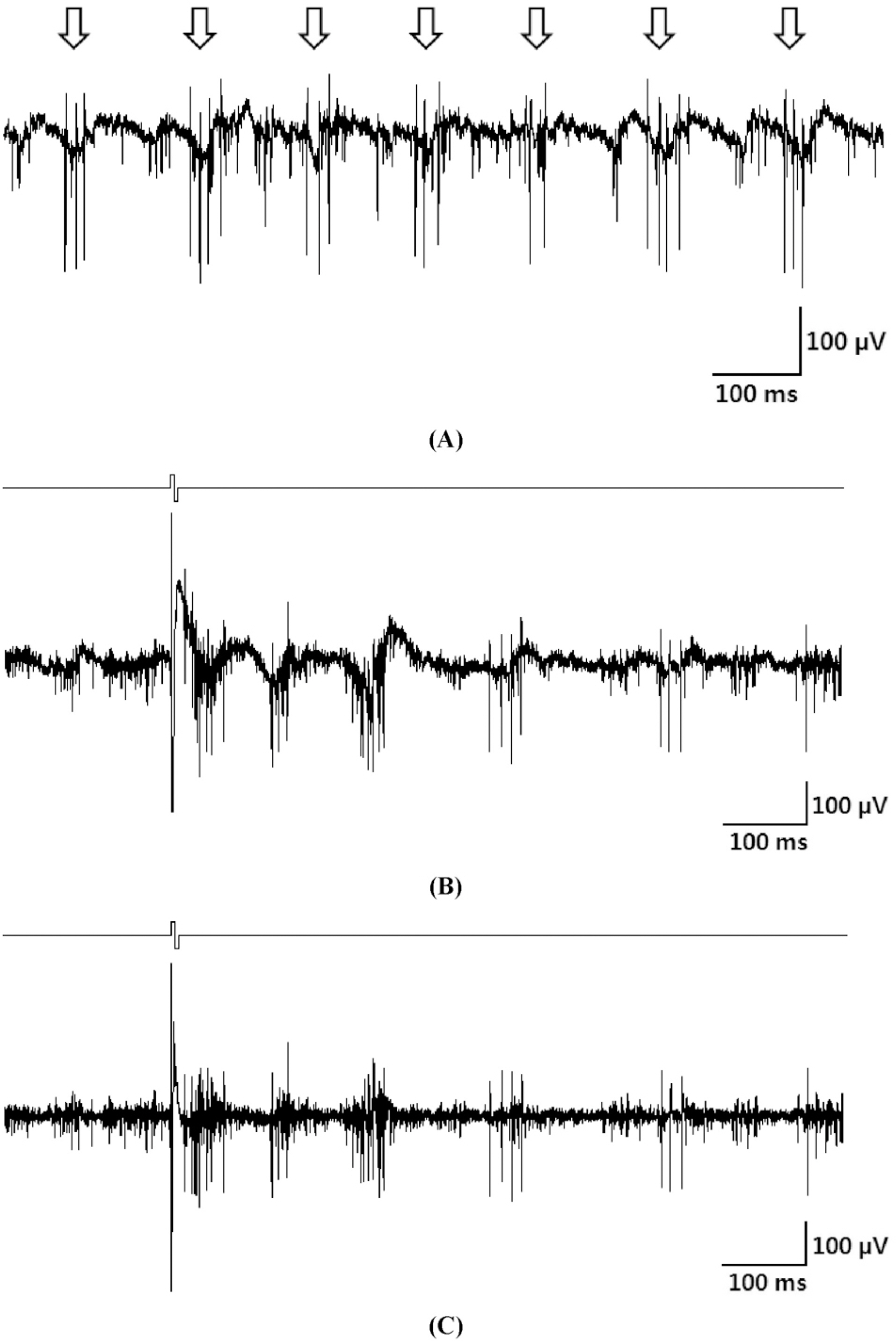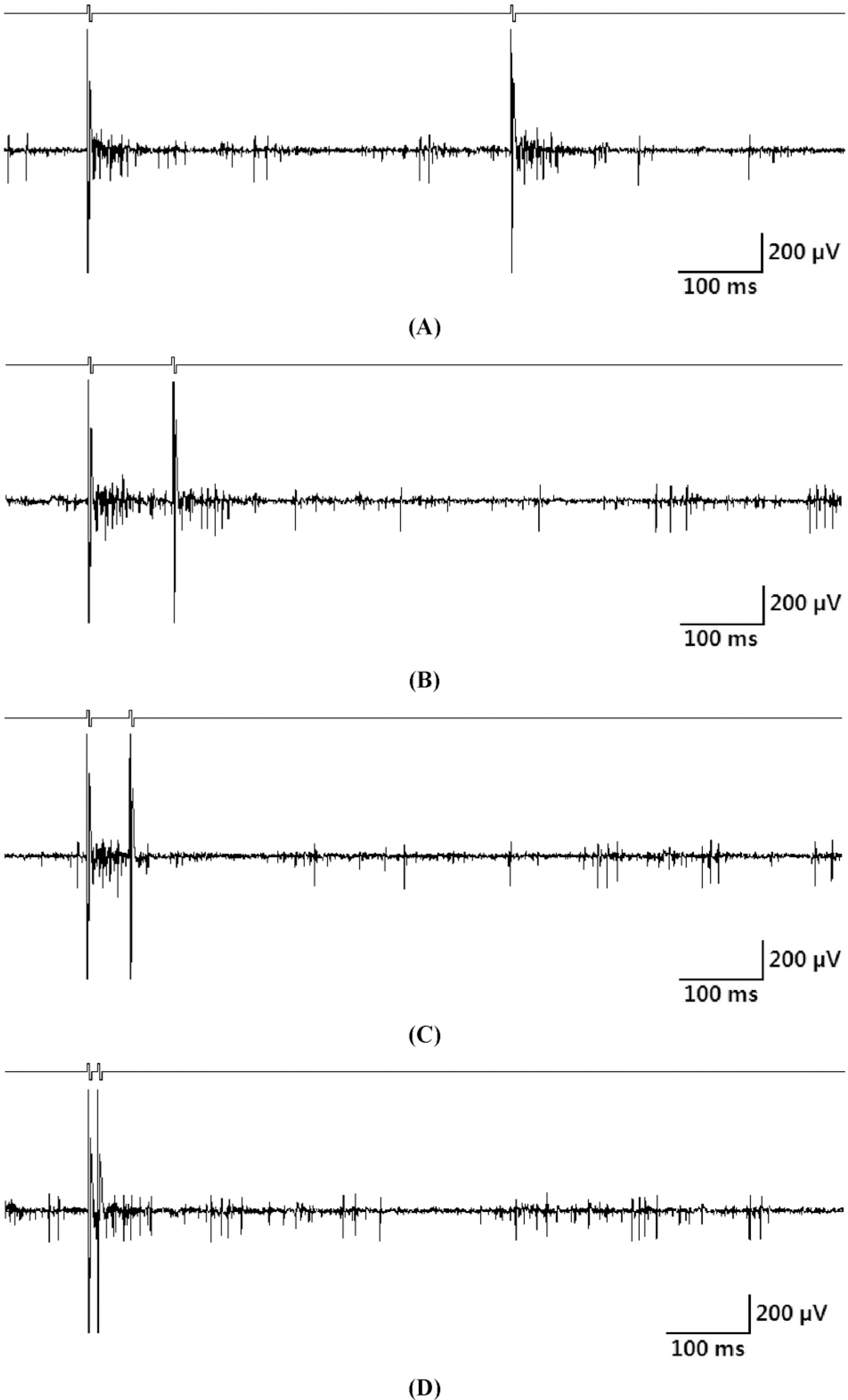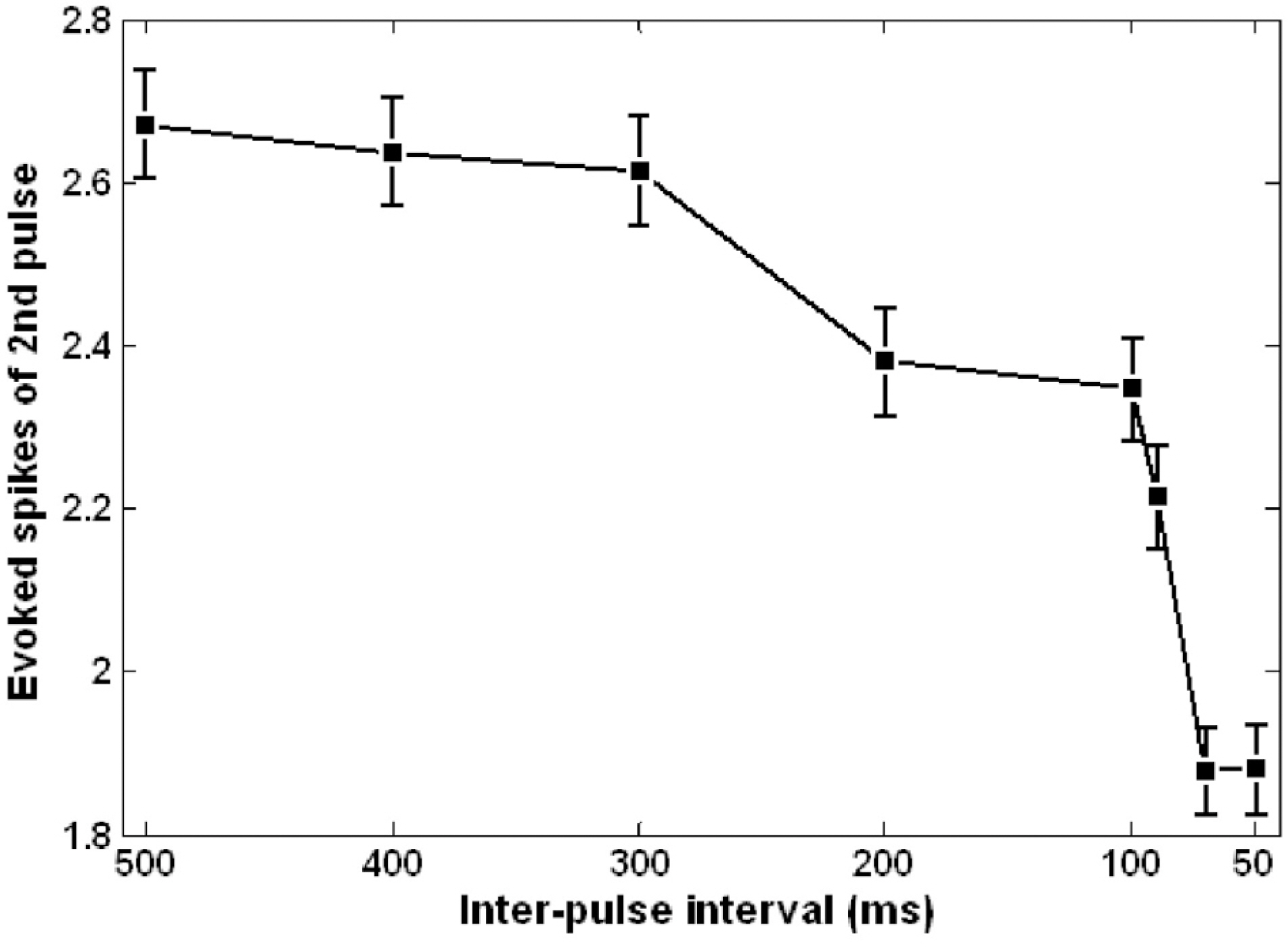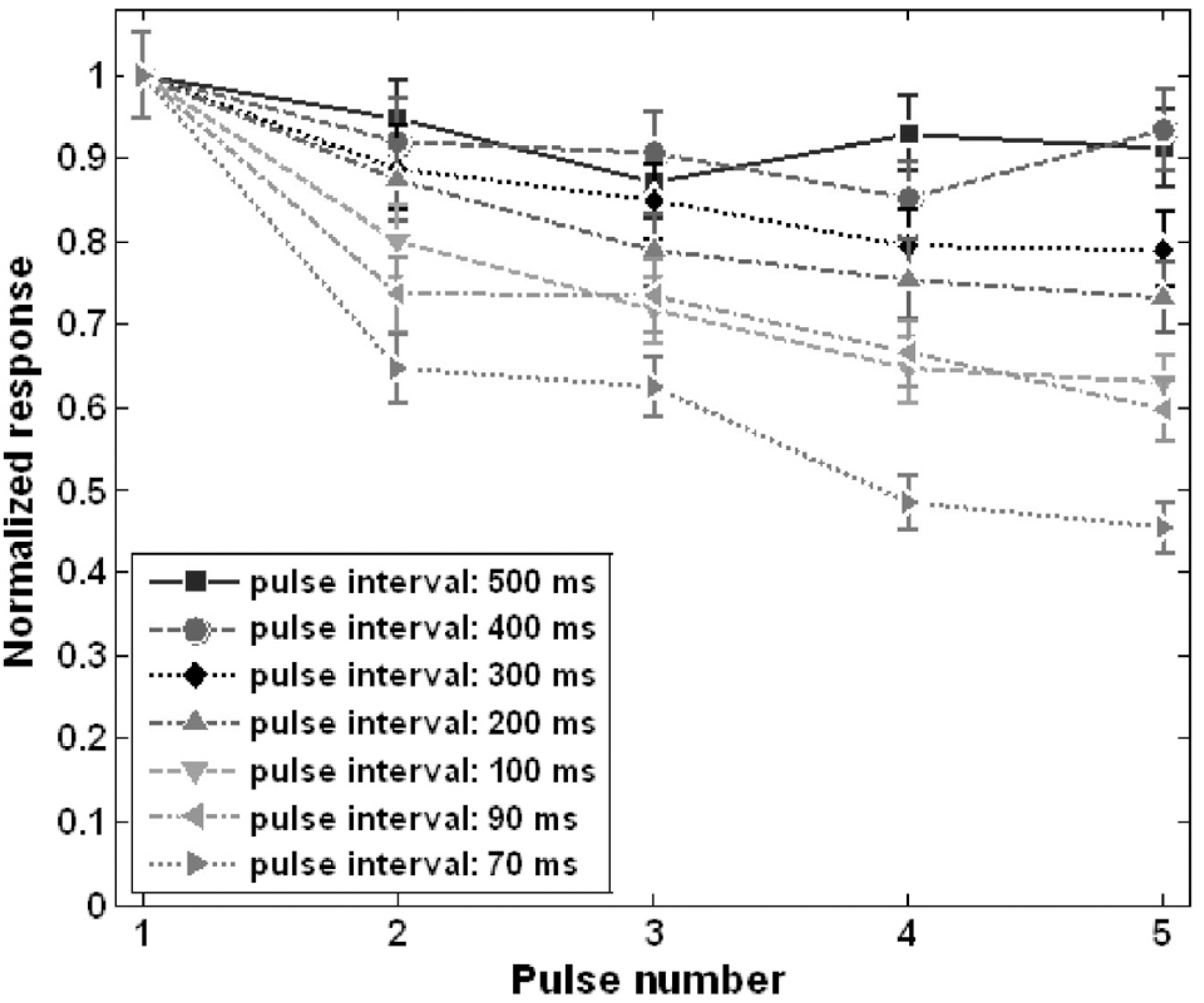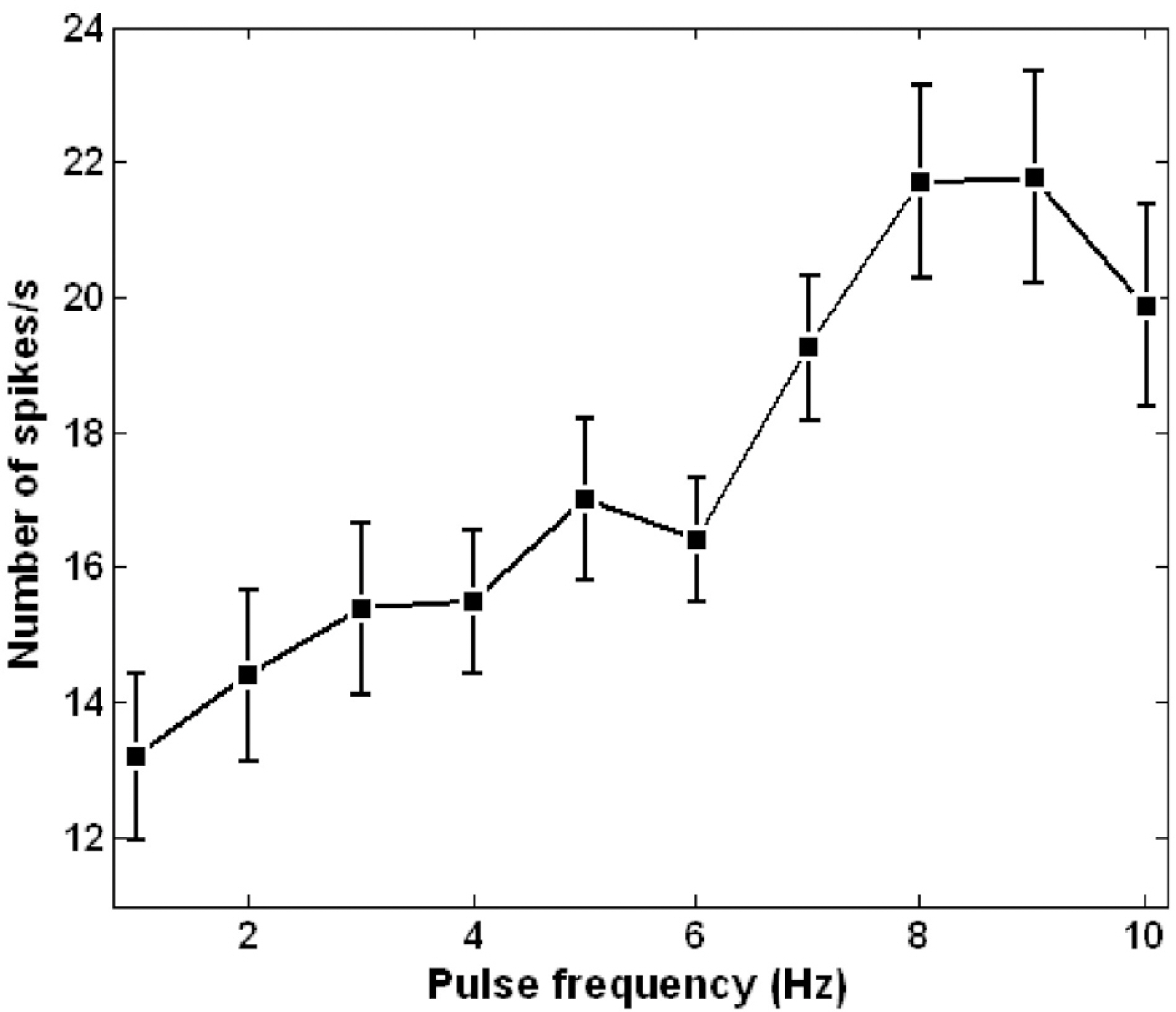Korean J Physiol Pharmacol.
2009 Dec;13(6):443-448. 10.4196/kjpp.2009.13.6.443.
Electrically-evoked Neural Activities of rd1 Mice Retinal Ganglion Cells by Repetitive Pulse Stimulation
- Affiliations
-
- 1Department of Biomedical Engineering, College of Health Science, Yonsei University, Wonju 220-710, Korea. khkim0604@yonsei.ac.kr
- 2Department of Physiology, Chungbuk National University School of Medicine, Cheongju 361-763, Korea.
- KMID: 2285379
- DOI: http://doi.org/10.4196/kjpp.2009.13.6.443
Abstract
- For successful visual perception by visual prosthesis using electrical stimulation, it is essential to develop an effective stimulation strategy based on understanding of retinal ganglion cell (RGC) responses to electrical stimulation. We studied RGC responses to repetitive electrical stimulation pulses to develop a stimulation strategy using stimulation pulse frequency modulation. Retinal patches of photoreceptor-degenerated retinas from rd1 mice were attached to a planar multi-electrode array (MEA) and RGC spike trains responding to electrical stimulation pulse trains with various pulse frequencies were observed. RGC responses were strongly dependent on inter-pulse interval when it was varied from 500 to 10 ms. Although the evoked spikes were suppressed with increasing pulse rate, the number of evoked spikes were >60% of the maximal responses when the inter-pulse intervals exceeded 100 ms. Based on this, we investigated the modulation of evoked RGC firing rates while increasing the pulse frequency from 1 to 10 pulses per second (or Hz) to deduce the optimal pulse frequency range for modulation of RGC response strength. RGC response strength monotonically and linearly increased within the stimulation frequency of 1~9 Hz. The results suggest that the evoked neural activities of RGCs in degenerated retina can be reliably controlled by pulse frequency modulation, and may be used as a stimulation strategy for visual neural prosthesis.
Keyword
MeSH Terms
Figure
Cited by 2 articles
-
Spontaneous Oscillatory Rhythm in Retinal Activities of Two Retinal Degeneration (
rd1 andrd10 ) Mice
Yong Sook Goo, Kun No Ahn, Yeong Jun Song, Su Heok Ahn, Seung Kee Han, Sang Baek Ryu, Kyung Hwan Kim
Korean J Physiol Pharmacol. 2011;15(6):415-422. doi: 10.4196/kjpp.2011.15.6.415.The advantage of topographic prominence-adopted filter for the detection of short-latency spikes of retinal ganglion cells
Jungryul Ahn, Myoung-Hwan Choi, Kwangsoo Kim, Solomon S. Senok, Dong-il Dan Cho, Kyo-in Koo, Yongsook Goo
Korean J Physiol Pharmacol. 2017;21(5):555-563. doi: 10.4196/kjpp.2017.21.5.555.
Reference
-
References
Ahuja AK., Behrend MR., Kuroda M., Humayun MS., Weiland JD. An in-vitro model of a retinal implant. IEEE Trans Biomed Eng. 55:1744–1753. 2008.Fried SI., Hsueh HA., Werblin FS. A method for generating precise temporal patterns of retinal spiking using prosthetic stimulation. J Neurophysiol. 95:970–978. 2006.
ArticleHesse L., Schanze T., Wilms M., Eger M. Implantation of retina stimulation electrodes and recording of electrical stimulation responses in the visual cortex of the cat. Graef Arch Clin Exp Ophthal. 238:840–845. 2000.
ArticleHornig R., Laube T., Walter P., Velikay-Parel M., Bornfeld N., Feucht M., Akguel H., Rössler G., Alteheld N., Notarp DL., Wyatt J., Richard G. A method and technical equipment for an acute human trial to evaluate retinal implant technology. J Neural Eng. 2:S129–S124. 2005.
ArticleHumayun MS., de Juan E Jr., Weiland JD., Dangnelie G., Katona S., Greenberg R., Suzuki S. Pattern electrical stimulation of the human retina. Vision Res. 39:2569–2576. 1999.
ArticleHumayun MS., Weiland JD., Fujii GY., Greenberg R., Williamson R., Little J., Mech B., Cimmarusti V., Boemel GV., Dagnelie G., de Juan E Jr. Visual perception in a blind subject with a chronic microelectronic retinal prosthesis. Vision Res. 43:2573–2581. 2003.
ArticleJensen RJ., Rizzo JF III. Responses of ganglion cells to repetitive electrical stimulation of the retina. J Neural Eng. 4:S1–S6. 2007.
ArticleJensen RJ., Ziv OR., Rizzo JF. Responses of rabbit retinal ganglion cells to electrical stimulation with an epiretinal electrode. J Neural Eng. 2:S16–S21. 2005.
ArticleKazemi M., Basham E., Sivaprakasam M., Wang G., Rodger D., Weiland J., Tai YC., Liu W., Humayun M. A test microchip for evaluation of hermetic packaging technology for biomedical prosthetic implants. Conf Proc IEEE Eng Med Biol Soc. 6:4093–4095. 2004.
ArticleMargolis DJ., Newkirk G., Euler T., Detwiler PB. Functional stability of retinal ganglion cells after degeneration-induced changes in synaptic input. J Neurosci. 28:6526–6536. 2008.
ArticleMerabet LB., Rizzo JF., Amedi A., Somers DC., Pascual-Leone A. What blindness can tell us about seeing again: merging neuroplasticity and neuroprosthesis. Nat Rev Neurosci. 6:71–77. 2005.Rizzo JF III., Wyatt J., Loewenstein J., Kelly S., Shire D. Perceptual efficacy of electrical stimulation of human retina with a micro-electrode array during short-term surgical trials. Invest Ophth Vis Sci. 44:5362–5369. 2003.Ryu SB., Lee JS., Ye JH., Goo YS., Kim CH., Kim KH. Analysis of neuronal activities of retinal ganglion cells of degenerated retinal evoked by electrical pulse stimulation. J Biomed Eng Res. 30:347–354. 2009a.Ryu SB., Ye JH., Lee JS., Goo YS., Kim KH. Characterization of retinal ganglion cell activities evoked by temporally patterned electrical stimulation for the development of stimulus encoding strategies for retinal implants. Brain Res. 1275:33–42. 2009b.
ArticleSekirnjak C., Hottowy P., Sher A., Dabrowski W., Litke AM., Chichilnisky EJ. Electrical stimulation of mammalian retinal ganglion cells with multielectrode arrays. J Neurophysiol. 95:3311–3327. 2006.
ArticleSeo JM., Kim SJ., Chung H., Kim ET., Yu HG., Yu YS. Biocompatibility of polyimide microelectrode array for retinal stimulation. Mater Sci Eng C. 24:185–189. 2004.
ArticleSivaprakasam M., Wentai L., Guoxing W., Weiland JD., Humayun MS. Architecture tradeoffs in high-density microstimulators for retinal prosthesis. IEEE Trans Circuits Syst I-Regul Pap. 52:2629–2641. 2005.
ArticleStasheff SF. Emergence of sustained spontaneous hyperactivity and temporary preservation of OFF responses in ganglion cells of the retinal degeneration (rd1) mouse. J Neurophysiol. 99:1408–1421. 2008.
ArticleStett A., Barth W., Weiss S., Haemmerle H., Zrenner E. Electrical multisite stimulation of the isolated chicken retina. Vis Res. 40:1785–1795. 2000.
ArticleVeraart C., Raftopoulos C., Mortmer JT., Delbeke J., Pins D., Michaus G., Vanlierde A., Parrini S., Wanet-Defalqu M. Visual sensations produced by optic nerve stimulation using an implanted self-sizing spiral cuff electrode. Brain Res. 813:181–186. 1998.
ArticleYe JH., Goo YS. The slow wave component of retinal activity in rd/rd mouse recorded with a multi-electrode array. Physiol Meas. 28:1079–1088. 2007.Zrenner E. Will retinal implants restore vision? Science. 295:1022–1025. 2002.
Article
- Full Text Links
- Actions
-
Cited
- CITED
-
- Close
- Share
- Similar articles
-
- Multiple consecutive-biphasic pulse stimulation improves spatially localized firing of retinal ganglion cells in the degenerate retina
- Spontaneous Oscillatory Rhythm in Retinal Activities of Two Retinal Degeneration (rd1 and rd10) Mice
- Amplitude Modulation-based Electrical Stimulation for Encoding Multipixel Spatiotemporal Visual Information in Retinal Neural Activities
- Comparison of Retinal Ganglion Cell Responses to Different Voltage Stimulation Parameters in Normal and rd1 Mouse Retina
- Effect of Stimulus Waveform of Biphasic Current Pulse on Retinal Ganglion Cell Responses in Retinal Degeneration (rd1) mice

